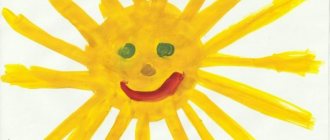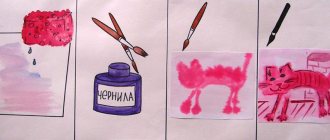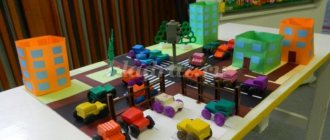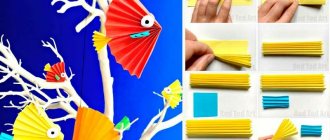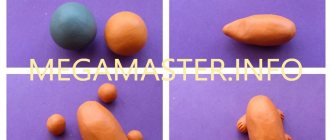Self-analysis of classes in the preparatory group
On the theme “Autumn. Trees. Getting to know the sound [I]"
Speech therapy topic: Sound [and]
Grammar topic: Formation of qualitative and possessive adjectives
Lexical topic: Autumn. Trees. When planning the lesson, the following goals were set: correctional-educational, correctional-developmental, correctional-educational goals.
Correctional and educational:
1. Cultivating attention to the sound side of speech, the formation of phonemic perception:
- clarification of the correct pronunciation of the sound: [and]
- development of articulatory motor skills;
- auditory discrimination of studied vowels;
- isolating a vowel sound from the beginning and end of a word in the stressed position of the sound [and];
- isolating the vowel sound [i] from the composition of the word in the stressed position;
- developing the ability to characterize sound;
- formation of concepts: vowel sound.
2. Consolidation of knowledge about trees (names of trees, their structure, external signs; ability to distinguish trees by external signs).
3. Raising attention to changes in the grammatical forms of words, methods of word formation and the formation of grammatical means of the language and word formation skills:
- formation of singular and plural present tense verbs (yellowed, fallen, swirled);
- formation of possessive adjectives (oak leaves);
- formation of qualitative adjectives (Cold, windy, warm, sunny, cloudy, gray, boring, sad)
- formation of complex words (leaf fall);
- drawing attention to the polysemy of words (needle);
- formation of words with diminutive - affectionate suffixes (leaf - leaf, leaf, tree - sapling, birch - birch tree, fir tree - fir tree, oak - oak tree).
4. Development of the prosodic side of speech.
5. Development of mental processes: auditory and visual perception, memory, attention; formation of mental operations (skills of analysis, synthesis, comparison, generalization).
Correctional and developmental: develop auditory attention and memory, articulatory, fine and gross motor skills, coordination of speech with movement.
Correctional and educational: developing skills of cooperation, mutual understanding, goodwill, independence, initiative, responsibility. Fostering love and respect for nature.
The entire lesson was structured taking into account the requirements of the Federal State Educational Standard:
the structure of material and technical support reflected the specific requirements for the organization of space (I used an equipped speech therapy room), the organization of a temporary training regime - the lesson was held in the morning, the use of TSO and ensuring comfortable access for children with severe speech impairments to education, special educational and didactic materials that meet educational needs - I used the following equipment: a computer, a magnetic board, demonstration material (pictures depicting different trees and leaves, pictures depicting a hedgehog, a spruce branch, a needle), natural material in the form of dried tree leaves, speech therapy aid Tsukanova SP., Betz L.L. “Teaching a child to speak and read.”
The lesson carried the maximum load, was structured taking into account psychophysiological individual characteristics, and had connections with all educational areas:
- social and communicative development (development of communication and interaction of the child with the teacher - speech therapist, peers, formation of a positive attitude towards the lesson;
- cognitive development (acquaintance and assimilation of new material.);
- speech development (answering questions, reasoning);
- artistic and aesthetic development (acquaintance with the works of A.N. Pleshcheev, P.I. Tchaikovsky);
- physical development (physical exercises, finger gymnastics).
All this had a positive impact on children’s activities (learning to read and write, developing grammatical categories).
The goals of the lesson were realized through the following methods: demonstration, a series of questions (supporting, clarifying, searching, pronouncing answers - individually, in chorus, motivation (say it correctly, etc.). The content of the children’s activities in the lesson corresponded to the goals, the tasks were arranged in an increasing order difficulties.
The organizational moment helped to concentrate the children’s attention and activate in their memory previously acquired knowledge on the lexical topic “Autumn”, “Trees”. Speech classes are always difficult for children; many concepts are abstract for children. To achieve optimal results from the lesson, I introduced techniques that increase motivation (surprises from Autumn). In a speech therapy lesson, it is necessary to maintain a clear structure of construction, each part of the lesson fulfills its specific purpose.
In the lesson, I selected tasks for the formation of lexical and grammatical categories and the development of coherent speech, which meets the requirements for correctional classes. Reliance on play as the leading activity of preschoolers and the mandatory inclusion of various types of games in speech therapy classes provided a pronounced positive effect both in overcoming speech disorders and in the development of cognitive mental processes. (d/i “Collect a picture”, d/i “Which tree is the leaf from?”, breathing exercise “Blow a leaf away”, d/i “Guess the riddle and identify the first sound in the answer”). The emotional mood was ensured by entertaining game techniques, imagery and colorfulness of the material, as well as a trusting relationship between the speech therapist and children, the creation of a situation of success in weak children, encouragement, and psychological comfort in the child’s soul.
The lesson took place with a change of activities (at tables, at the blackboard, on the carpet), the children were completely immersed in the atmosphere of entertaining tasks and performed them with particular interest. Throughout the lesson, the following forms of children's activity were used: individual, subgroup.
Individual tasks (work in individual albums) made it possible to identify the degree of mastery of the material by each child; frontal work was provided by the subgroup.
Personally-oriented interaction with children (listening to the opinion of each child, supporting their reasoning with a positive assessment) helped create a situation of success for each of them. During the lesson, the following mental processes were activated: auditory attention in working on word formation and composing sentences; logical thinking, visual perception (through cut-out pictures). As a necessary element of a speech therapy lesson, I used tasks for the development of fine motor skills (picture collection).
An entertaining physical activity provided relaxation and a change of actions, but at the same time activated the children for further work. In the final part of the lesson, the results of the lesson were summed up and a positive assessment was given of the activities of each child in the lesson, which had a psycho-emotional orientation.
The result obtained confirmed the effectiveness of the methods and techniques I selected for teaching children literacy and the formation of grammatical categories, and taking into account the results of the lesson will help monitor the progress of further learning, establish feedback, and allow us to outline ways for further work with children, both in classes and in other activities .
MU “Rehabilitation Center for Children and Adolescents with Disabilities “Tredi” Department of Social Rehabilitation. Author of the material: Boytseva Irina Gennadievna
Also on topic:
Lesson summary on teaching literacy in preparatory class V type. Theme: “Sound and letter s”. Self-analysis of the lesson
Preview:
Self-analysis of GCD for drawing using non-traditional techniques “Winter Landscape”
Topic: “Winter landscape”
The lesson was conducted with children from the preparatory group; there were (7) children present. Children easily make contact with adults. They know how to hear and listen to the teacher.
When developing this lesson summary, I first of all took into account the age and mental individual characteristics of the children in the preparatory group.
Taking all this into account, I outlined the goal, objectives, content of the lesson, determined the form of delivery, methods, techniques and means necessary for positive results.
Purpose of the lesson: to evoke aesthetic feelings towards nature and its images using an unconventional drawing technique.
During the lesson it was expected to solve the following problems
- To clarify children’s ideas about landscape as a genre of painting;
- Develop the ability to correctly ask a question that requires a clear answer;
- Develop creative abilities in the process of one’s own artistic activity through the use of non-traditional materials and drawing methods;
- To promote the development of the ability to analyze and express one’s opinion;
- Develop cognitive processes; Mental operations: analysis, comparison, generalization;
- Cultivate interest in understanding nature, displaying ideas in visual arts.
In accordance with the requirements of the Federal State Educational Standard, she used the following types of activities: gaming, cognitive, productive, motor.
Methods and techniques:
-methods of consciousness formation (individual and frontal conversation);
-methods of organizing activities and developing behavioral experience (games, speech situations);
-methods of stimulating behavior (encouragement);
-methods of control, self-control and self-assessment (survey, analysis of the results of one’s own activities);
-methods of organizing and implementing cognitive activity (story, modeling a picture);
-methods of saving, preserving and strengthening health (games “Bring the Picture to Life”, finger play “Snowball”)
To successfully solve the identified problems, I have prepared the following:
Preparatory work: conversation about winter; viewing and talking about landscape paintings; drawing “Autumn landscape”; the use of modeling in direct educational activities.
Equipment and materials: models, tinted sheets of cardboard (for each child), stacks, skewers, ready-made dough for drawing; rags, Velcro pictures depicting objects and natural phenomena, plastic cups, audio recording of P.I. Tchaikovsky “Seasons. February” exhibition of paintings, presentation of paintings by famous artists.
The end result for the child: knows how to depict a winter landscape using an unconventional drawing technique, plans his activities and implements a preliminary plan, freely navigates a limited surface.
I think that drawing with non-traditional techniques aroused interest and activity among children.
The lesson consisted of three parts.
Contributed to the creation of psychological comfort. We set the children up for active work, positive contact with each other, provided psycho-emotional release, and created interest in the upcoming activity.
2. Main part.
Aimed at creating a positive emotional mood and developing the educational situation itself. This part of the educational activity used a combination of game motivation, visual, verbal and practical methods.
1. To describe natural phenomena in winter, I used the didactic exercise “Winter - good, bad...”, as a result of which the children’s vocabulary is enriched with adjectives characterizing natural phenomena.
2. I solved the problem of developing visual perception, memory and logical thinking and cognitive activity in the process of viewing landscape paintings and working with model pictures related to the landscape.
3. Emotional expressiveness and the ability to convey the mood of a picture were reflected in the theatrical sketch-improvisation “A Picture Alive”. The children's ability to correlate words with movements and the expressiveness of performing movements was strengthened.
Determining the purpose of the topic (drawing a landscape)
Physical education was carried out. In order to develop fine motor skills of the fingers.
Independent productive activity.
3. Final part.
Assessment of children's performance and self-esteem. Summing up the results of the GCD.
All stages of the lesson were interconnected and interdependent, subordinated to the given topic and goals of the lesson. Changing the type of activity at each stage of the lesson helped prevent fatigue.
I don’t forget that play is the leading activity for preschool children, so I offered the children the games “Winter – good, bad...”, “Picture Alive”.
During the lesson, to ensure the efficiency of the children's team, I used the following forms of organizing children's activities:
Team work with model pictures.
— Individual. Each child drew independently.
Throughout the entire lesson, I paid attention to the children’s speech: I sought complete answers, posed searching questions about how we could draw, and created conditions for dialogue with the children.
During the lesson, the children were active - they participated in the game and answered questions.
The children's interest remained throughout the lesson. The children were attentive.
Summing up the lesson, I involved the children in this and asked them to speak on the topic of what we know about painting and what other ways can we draw pictures.
CONCLUSIONS: – The stated topic was fully consistent with the content of the lesson.
— I believe that I managed to fully implement the assigned tasks.
Source
